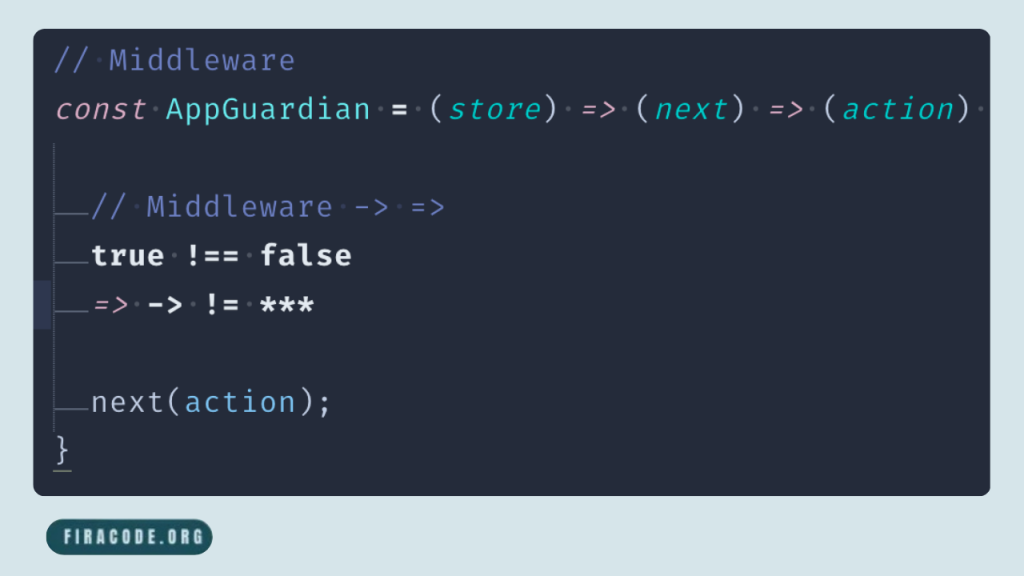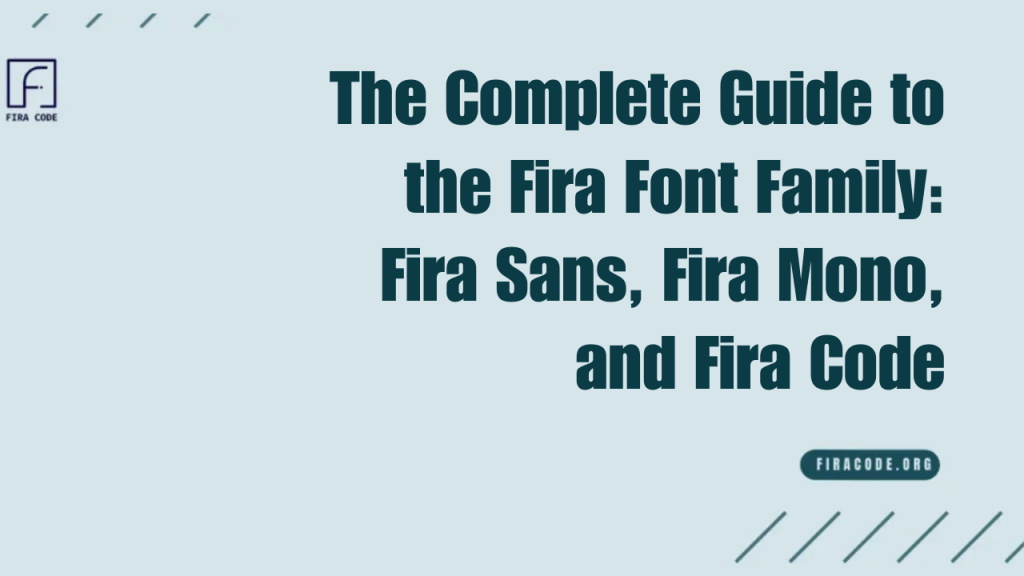Table of Contents
ToggleIntroduction
The Fira Font Family is a popular and versatile collection of typefaces designed to meet the needs of modern users, from graphic designers to software developers. Comprising Fira Sans, Fira Mono, and Fira Code, this family offers a range of fonts tailored for readability, style, and coding efficiency.
Initially developed by Mozilla, the Fira fonts have become widely adopted thanks to their clean design, open-source availability, and support for programming ligatures.
Overview of Fira Fonts
The Fira font family is a versatile collection of typefaces designed to enhance readability and style across different platforms. It includes Fira Sans, a clean and modern sans-serif font; Fira Mono, a monospaced font ideal for coding; and Fira Code, a specialized version of Fira Mono that supports programming ligatures.
History and Development
Initially commissioned by Mozilla to improve the readability of Firefox OS, the Fira font family was developed by Erik Spiekermann and his team. Since its release, Fira has gained popularity due to its clear design, open-source availability, and regular updates.
Why Choose Fira Fonts?
Fira fonts offer a unique balance between aesthetic appeal and practical functionality. Their open-source nature means they are free to use and customize, making them accessible to a broad audience.
What Is the Fira Font Family?
The Fira Font Family is a versatile collection of typefaces designed for clarity, readability, and style across various uses. Mozilla initially developed it and includes three main fonts: Fira Sans, Fira Mono, and Fira Code. By using the Fira Code font family, developers benefit from a monospaced typeface with ligatures specifically optimized for programming environments, while Fira Sans and Fira Mono cater to general text and monospaced needs, respectively.
Understanding Fira Sans, Fira Mono, and Fira Code
- Fira Sans is a clean, modern sans-serif font ideal for body text, interfaces, and branding. It focuses on readability and a professional look.
- Fira Mono is a monospaced font designed primarily for coding, where each character occupies the same width, making it easier to read and debug code. See Fira Code Mono logical ligatures for usage examples.
- Fira Code builds on Fira Mono by adding programming ligatures special combined characters that improve code readability and reduce visual clutter for developers. Learn more about setting up Fira Code in Emacs.
Key Features of Each Font
- Fira Sans
- Elegant and highly legible
- Multiple weights and styles for flexibility
- Suitable for web, print, and UI design
- Fira Mono
- Monospaced design for coding precision
- Clear character distinction to avoid confusion
- Supports extended character sets and symbols
- Fira Code
- Includes programming ligatures for common coding symbols
- Enhances code aesthetics and readability
- Compatible with prominent code editors like VS Code, Atom, and Sublime Text
Differences Between Fira Sans, Mono, and Code
- Purpose: Fira Sans targets general text and UI, Fira Mono is optimized for coding without ligatures, and Fira Code adds ligatures for enhanced programming clarity.
- Design: Fira Sans is a proportional font, while both Mono and Code are monospaced fonts.
- Functionality: Fira Code includes extra ligatures, making it unique among the three for developers seeking visual improvements in their code.
How to Install Fira Fonts on Different Platforms
Installing Fira fonts on various operating systems is a simple process that ensures you can use these versatile fonts everywhere. For Linux users, see our guide on installing Fira Code on Ubuntu.
Installing Fira Fonts on Windows
To install Fira fonts on Windows, start by downloading the font files from the official source or a trusted website. Once the files are saved on your computer, simply double-click each font file to open it in the Windows Font Viewer. From there, clicking the Install button will add the font to your system. After installation the fonts will be available to use in all applications that support custom fonts such as word processors, design software and code editors.
Installing on macOS
On macOS installing Fira fonts is straightforward. After downloading the font files, open them using the Font Book application, which is the default font manager on macOS. Font Book will display a preview of the fonts, and you can click Install Font to add them to your system’s font library.
Installing on Linux (Including Arch Linux)
Linux users can manually place font files in the system fonts directory or use package managers. Our guides on installing Fira Code on Linux and switching from Cascadia Code to Fira Code provide step-by-step instructions.
How to Use Fira Fonts Effectively
The Fira font family provides versatile options that can be effectively used in various contexts to enhance readability and style. Fira Sans is an excellent choice for general text, user interfaces, and branding due to its clean, modern design, which ensures easy reading across both digital and print media.
Best Use Cases for Fira Sans
Fira Sans is a versatile sans-serif font renowned for its clean and modern appearance, making it an ideal choice for a wide range of applications. It works exceptionally well in user interfaces, websites, and mobile apps where readability and a contemporary look are essential. Additionally, its balanced letterforms and excellent legibility make it a great choice for body text in print materials presentations and branding projects.
Programming with Fira Mono and Fira Code
Fira Mono and Fira Code are specially crafted for developers and programmers. Fira Mono is a monospaced font that ensures each character occupies the same horizontal space, thereby maintaining code alignment and readability. Fira Code takes this a step further by including programming ligatures, which are combined characters, such as or “=>”, rendered as single, visually appealing symbols.
Customizing and Pairing with Other Fonts
To maximize the effectiveness of the Fira font family, customizing and pairing these fonts thoughtfully is key. Adjusting font weights, sizes, and letter spacing can help tailor the fonts to fit your specific design or coding environment. When it comes to pairing, Fira Sans pairs well with serif fonts for a balanced and professional look, adding contrast that helps different content types stand out.

Understanding Fira Code and Its Programming Ligatures
Fira Code is a monospaced font explicitly designed for programmers. What sets it apart from regular coding fonts is its support for programming ligatures, special character combinations that transform multiple characters into a single, more readable symbol.
What Are Programming Ligatures?
Programming ligatures are typographic features that combine multiple characters into one cohesive symbol. In the context of coding fonts like Fira Code, ligatures replace standard multi-character operators, such as with single glyphs designed to enhance readability. These ligatures don’t change the actual code but help developers quickly recognize patterns and operators making the code visually cleaner and more intuitive without affecting how the code executes.
Benefits of Using Fira Code for Developers
Using Fira Code offers several benefits for developers. Its ligatures enhance the readability of complex programming symbols, reducing eye strain during long coding sessions. The monospaced design ensures consistent spacing, which is critical for maintaining code alignment and spotting errors easily.
How to Enable Ligatures in Popular Code Editors
Enabling ligatures in code editors usually involves simple settings adjustments. Most modern editors, such as Visual Studio Code, JetBrains IDEs, and Sublime Text, support ligatures when using fonts like Fira Code. Typically, you need to select Fira Code as your font and then enable the “font ligatures” option in the editor’s settings or preferences.
Troubleshooting Common Issues with Fira Fonts
Despite their popularity, users may encounter issues with Fira fonts that can affect usability. Common problems include font rendering glitches, where characters appear blurry or misaligned, often related to display settings or outdated graphics drivers. Another issue may be that fonts do not display correctly in specific applications or browsers due to compatibility restrictions or missing font files.
Font Rendering Problems and Fixes
Font rendering issues can cause text to appear fuzzy, improperly spaced, or inconsistent across different devices and applications. These problems often arise due to system-level settings, such as ClearType on Windows, font smoothing on macOS, or GPU driver conflicts. Fixes usually involve adjusting these settings, updating drivers, or reinstalling fonts to ensure proper rendering.
Compatibility with Applications and Browsers
Fira fonts are widely compatible with most modern applications and web browsers, making them reliable choices for both design and development work. However older software or browsers may lack support for certain font features, such as ligatures or advanced OpenType functions. Ensuring your applications and browsers are up to date helps maintain compatibility and provides a seamless user experience.
Updating and Managing Font Versions
Keeping your Fira fonts updated is essential to benefit from improvements, bug fixes, and new features, such as added glyphs or enhanced ligature support. Font updates can be done by downloading the latest releases from official sources or using package managers if you installed the fonts through a system like Arch Linux.
Conclusion
The Fira font family offers a powerful and versatile set of typefaces designed to meet the needs of both designers and developers. Whether you choose the clean and modern Fira Sans for general text, the precise Fira Mono for coding, or the feature-rich Fira Code with programming ligatures, these fonts enhance readability and productivity across different platforms.
FAQs
What is the difference between Fira Sans, Fira Mono, and Fira Code?
Fira Sans is a clean, modern sans-serif font designed for general text and user interfaces. Fira Mono is a monospaced font, ideal for coding, as it provides uniform character spacing for improved readability.
Can I use Fira Code for non-programming purposes?
Yes, you can use Fira Code for non-programming purposes. While it’s optimized for coding with ligatures, it works well anywhere you want a monospaced font with a modern look. Just keep in mind that ligatures may change how certain character combinations appear.
Are Fira Fonts free to use for commercial projects?
Yes, Fira fonts are open-source and free to use for both personal and commercial projects. They are released under the SIL Open Font License, which allows modification, distribution, and commercial use without restrictions.
How do I enable ligatures in Visual Studio Code?
To enable ligatures in Visual Studio Code, first set Fira Code as your editor font by updating the editor.fontFamily setting. Then, turn on ligatures by setting editor.fontLigatures to true in the settings. This allows VS Code to render Fira Code’s programming ligatures correctly.
Is Fira Code compatible with all code editors?
Fira Code is compatible with most modern code editors and IDEs that support custom fonts and ligatures. Popular editors, such as Visual Studio Code, JetBrains IDEs, Sublime Text, and Atom, support it well. However, some older or less standard editors may not fully support ligatures.
Can I customize the appearance of Fira Fonts?
You can customize Fira fonts to some extent by adjusting font weights, sizes, and letter spacing within your applications. However, the font design itself cannot be altered unless you modify the open-source font files directly, which requires font editing tools and knowledge.
Latest post:


